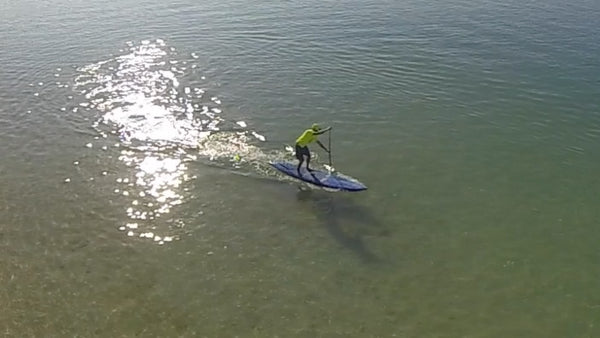When I first started Stand Up Paddling, I was struggling to catch waves. I was pulling on the paddle as hard as I could and figured the harder I pulled on the paddle and the more the shaft was bending, the more power I was applying and the faster the board would go. Despite pulling as hard as I could I was missing a lot of waves, I also kept breaking paddles. It seemed to make sense that the harder I pulled and the more the paddle shaft was bending, the faster I would go.
A big breakthrough for me came when Brian Keaulana gave me this tip after watching me try to catch a wave: "You are starting in third gear!"
He explained that first gear is short, quick strokes, way up in front, just tapping the water, not long, hard pulls. That was a turning point for me, I learned how to use these quick accelerating strokes and it worked like a charm. Not only was I no longer breaking paddles but my board would accelerate with just a few quick strokes and I started catching more waves. This technique also works well in downwinders, whenever you need to accelerate to catch a bump. Even in flatwater races you can use them at the start, after turns, or to catch up to a draft. So I encourage you to watch the video, try this first gear acceleration stroke, and you will be a more well rounded paddler. Not all strokes are the same, learn to use different gears when paddling and switch them up as needed.
The gear analogy works: everyone knows that if you start in third gear, you will wear out your transmission and clutch and no matter ho hard you gas the engine, you will not accelerate quickly. So take it easy on your body and gear and accelerate more quickly and easily by starting in first gear!
This video demonstrates how to accelerate quickly on a Stand Up Paddleboard by "starting in first gear". Quick, short, strokes create lift and smooth acceleration that will help you get the board on a plane to surf a wave or catch a bump in downwinders.
We hope you enjoy our videos, please give us a thumbs up, check out the other SUP tip videos on our channel and subscribe for our latest videos posted weekly. For more information on our weekly training group mentioned in the video, please click on this link: http://zenwaterman.blogspot.com/…/weekly-time-trials-in-haw…
Also check out our private coaching offerings here: http://blueplanetsurf.com/pages/lessons
Thank you for watching,
Aloha, Robert Stehlik
www.blueplanetsurf.com
www.blueplanetsurf.com
 |
| Quick, short bursts of power will help you get up to speed to catch a wave or bump |

 |
| On downwinders the goal is to get the board to plane over the surface of the water and surf the open ocean wind swells. |
Gear used in this video: Kai Zen paddle with 88 blade, the blue board is the 2016 12'6 x 28 Blue Planet Bump Surfer, the rasta board is the 14' x 28" Bump Rider. Drone video shot with the Hexo+ drone, land video by Evan Leong of standuppaddlesurf.net
Aloha,
Robert Stehlik
www.blueplanetsurf.com
Aloha,
Robert Stehlik
www.blueplanetsurf.com

